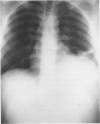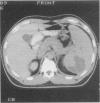Abstract
The modern era for splenic surgery for injury began in 1892 when Riegner reported a splenectomy in a 14-year-old construction worker who fell from a height and presented with abdominal pain, distension, tachycardia, and oliguria. This report set the stage for routine splenectomy, which was performed for all splenic injury in the next two generations. Despite early reports by Pearce and by Morris and Bullock that splenectomy in animals caused impaired defenses against infection, little challenge to routine splenectomy was made until King and Schumacker in 1952 reported a syndrome of "overwhelming postsplenectomy infection" (OPSI). Many studies have since demonstrated the importance of the spleen in preventing infections, particularly from the encapsulated organisms. Overwhelming postsplenectomy infection occurs in about 0.6% of children and 0.3% of adults. Intraoperative splenic salvage has become more popular and can be achieved safely in most patients by delivering the spleen with the pancreas to the incision, carefully repairing the spleen under direct vision, and using the many adjuncts to suture repair, including hemostatic agents and splenic wrapping. Intraoperative splenic salvage is not indicated in patients actively bleeding from other organs or in the presence of alcoholic cirrhosis. The role of splenic replantation in those patients requiring operative splenectomy needs further study but may provide significant long-term splenic function. Although nonoperative splenic salvage was first suggested more than 100 years ago by Billroth, this modality did not become popular in children until the 1960s or in adults until the latter 1980s. Patients with intrasplenic hematomas or with splenic fractures that do not extend to the hilum as judged by computed tomography usually can be observed successfully without operative intervention and without blood transfusion. Nonoperative splenic salvage is less likely with fractures that involve the splenic hilum and with the severely shattered spleen; these patients usually are treated best by early operative intervention. Following splenectomy for injury, polyvalent pneumococcal vaccine decreases the likelihood of OPSI and should be used routinely. The role of prophylactic penicillin is uncertain but the use of antibiotics for minor infectious problems is indicated after splenectomy.
Full text
PDF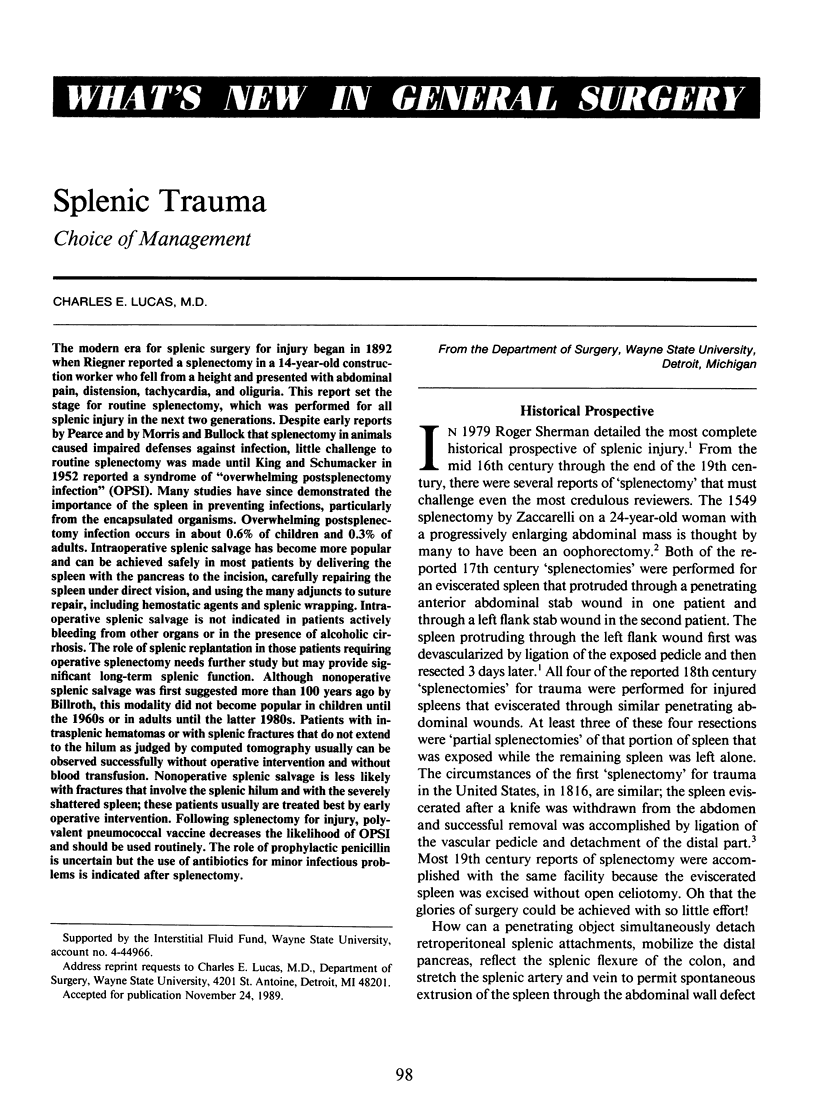

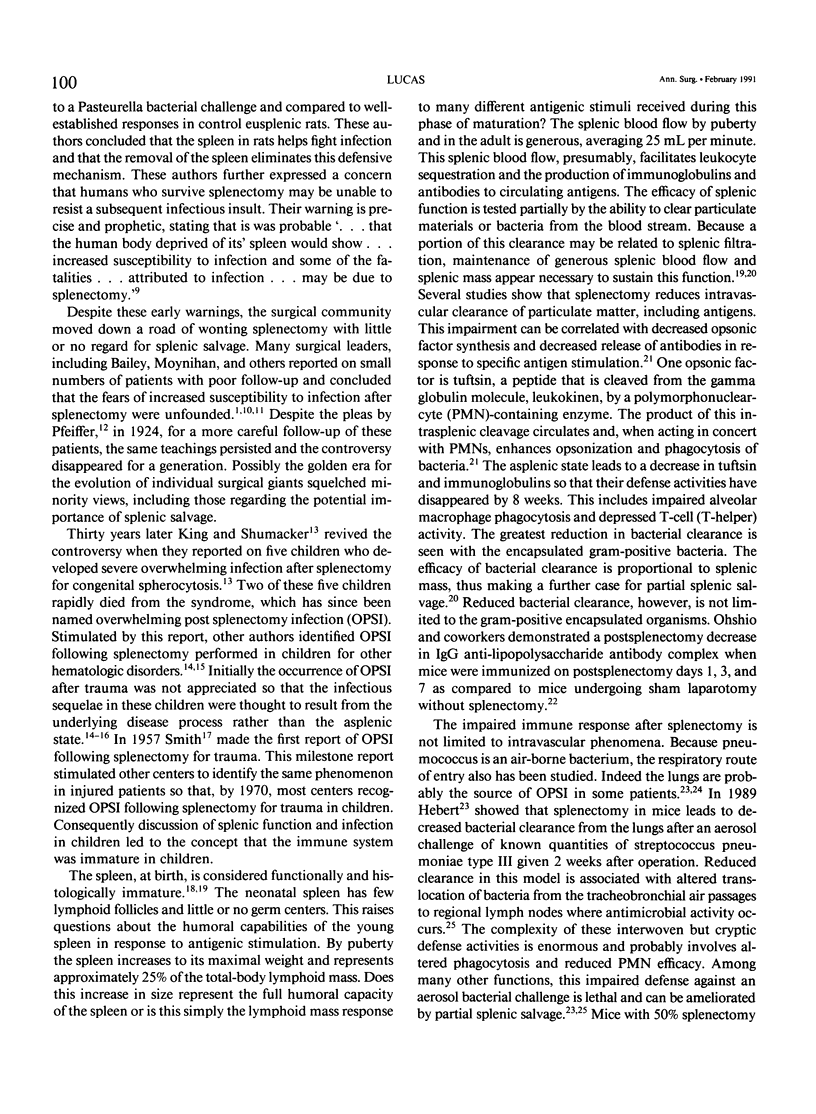

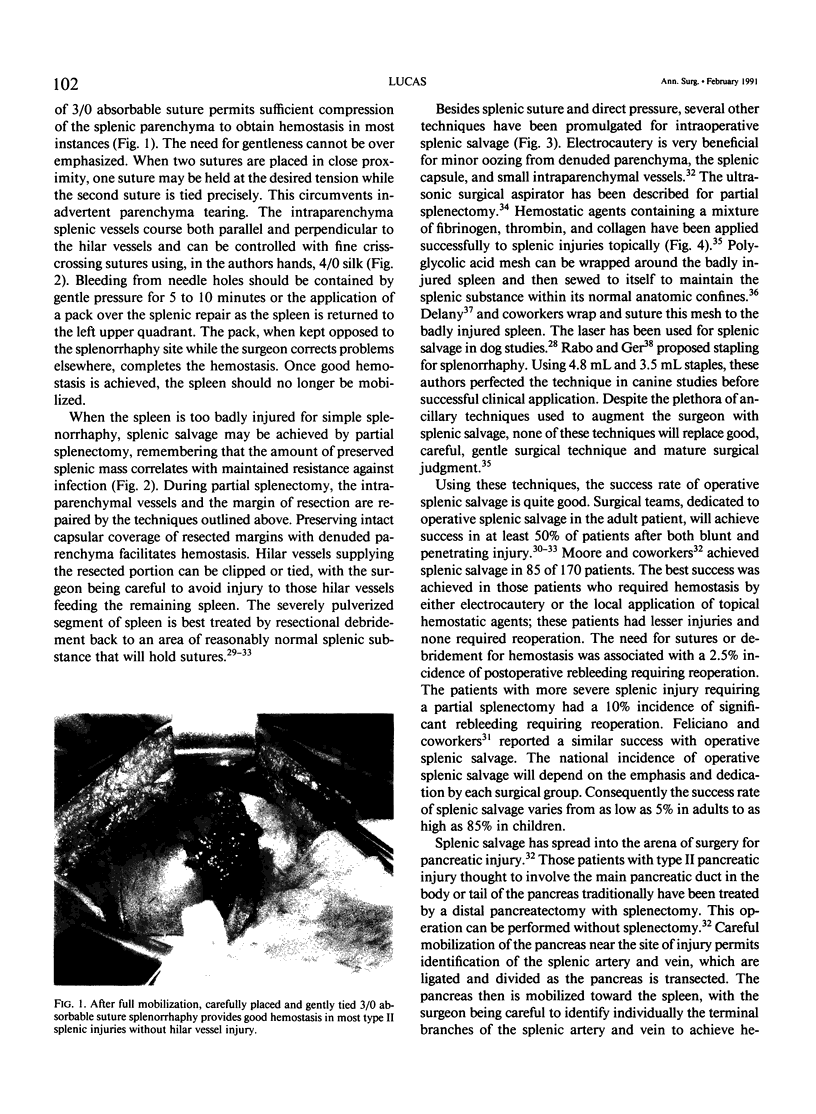
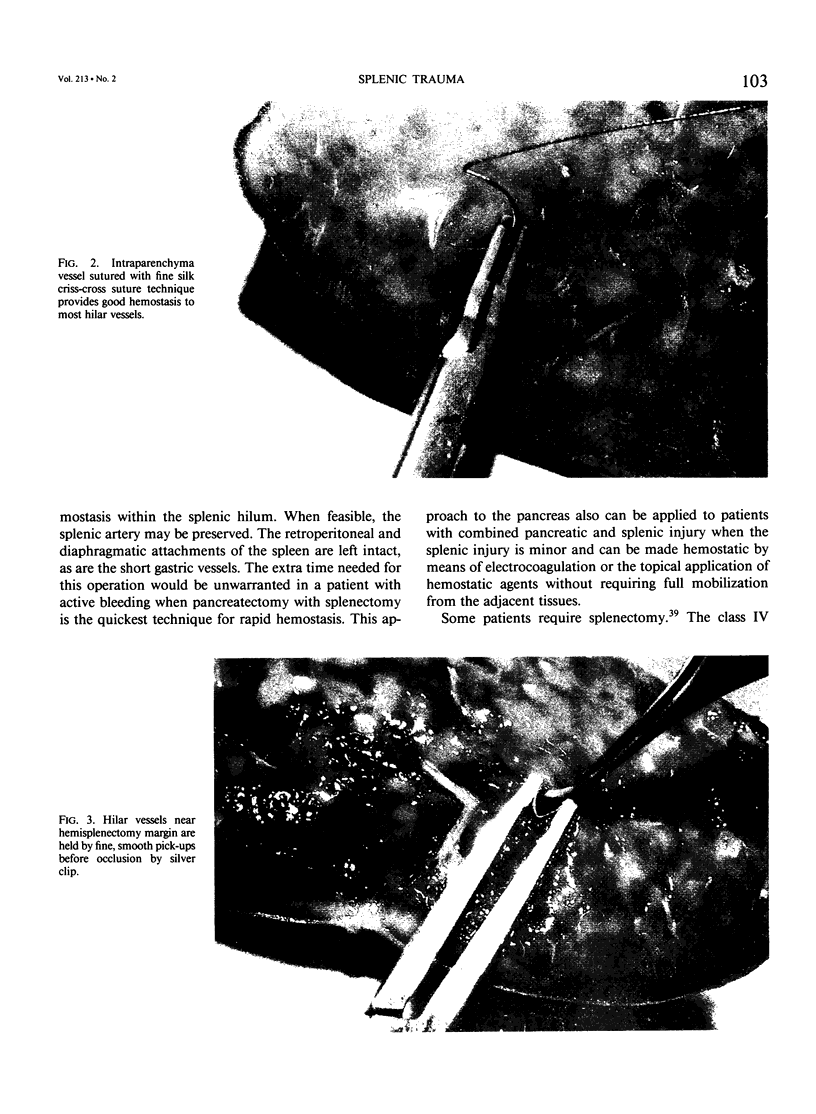
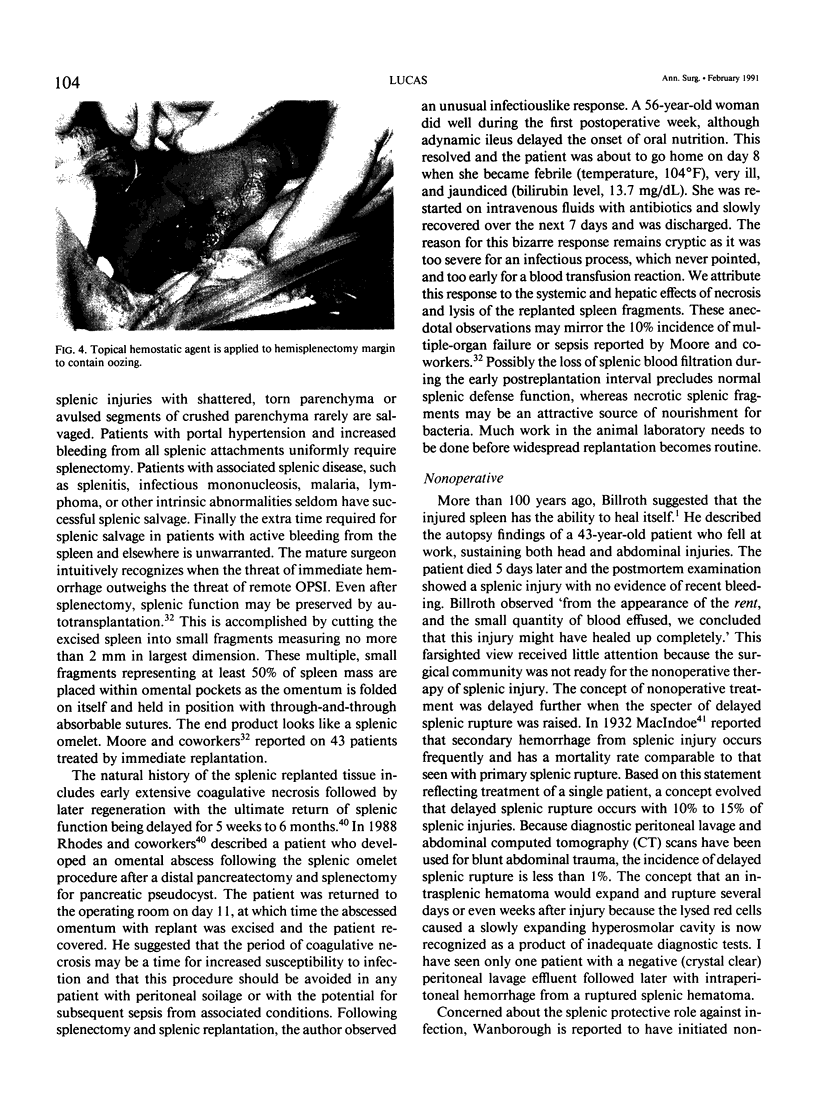
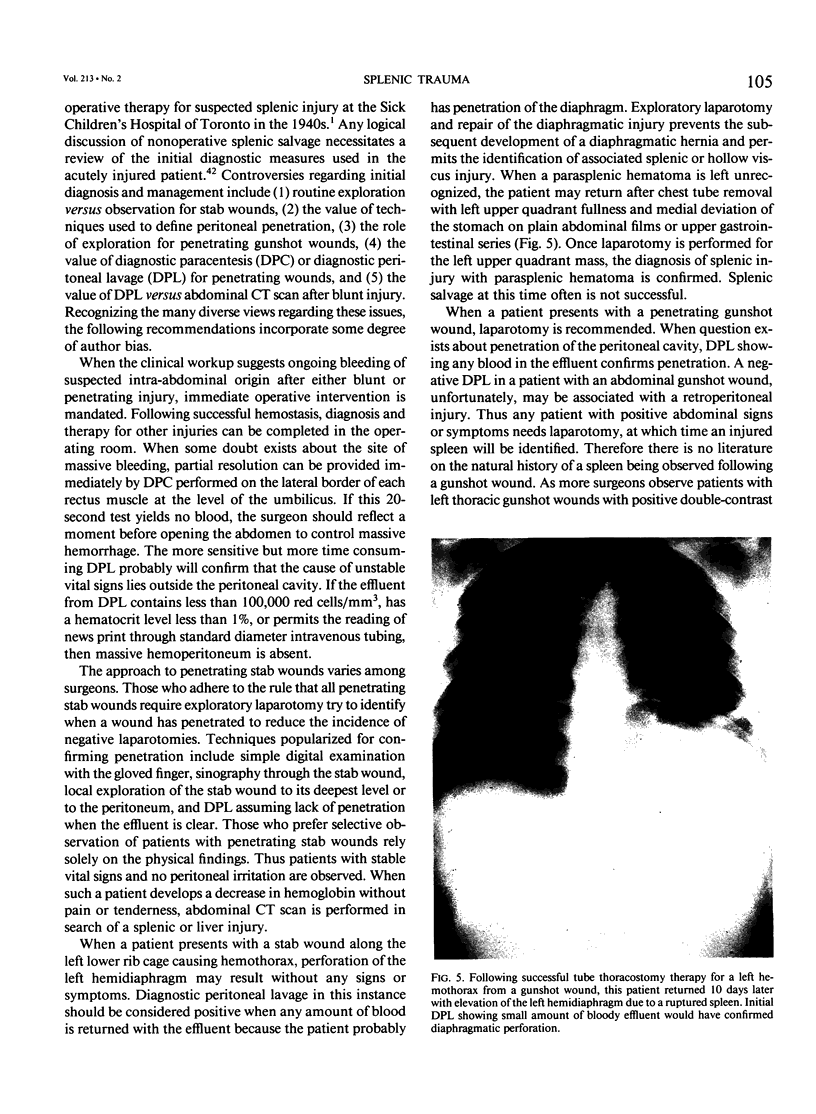
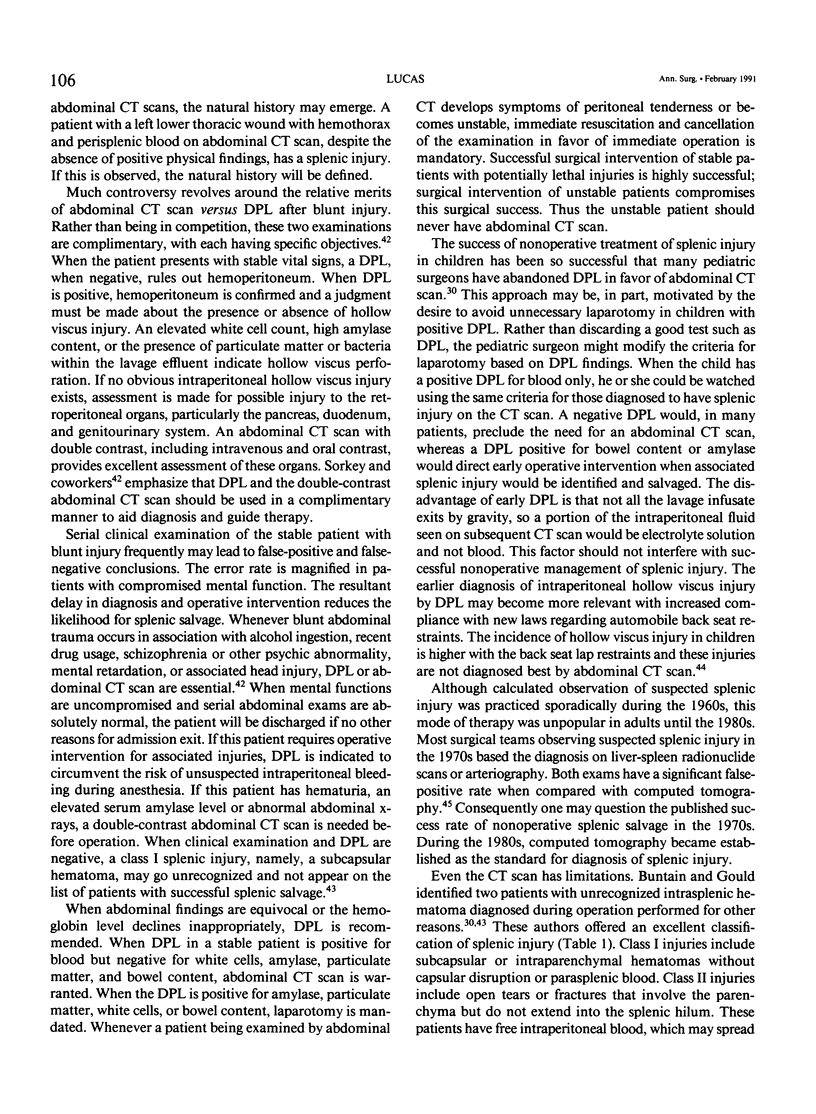
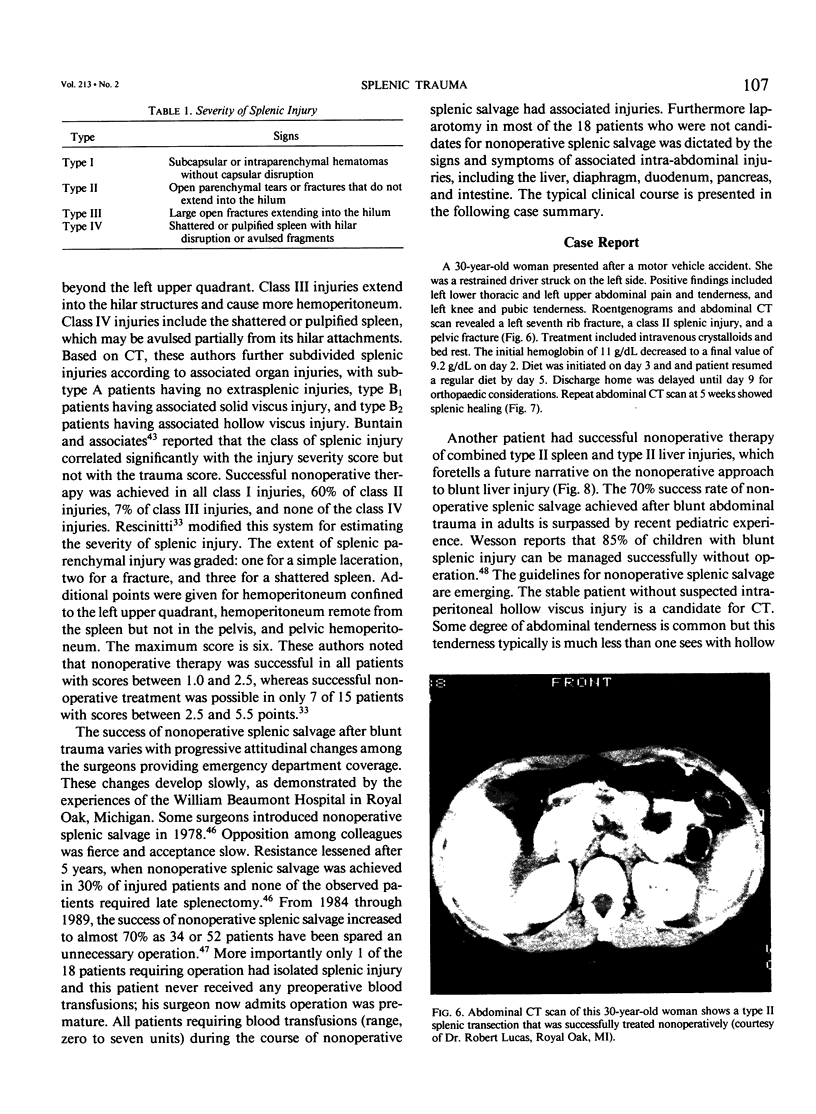
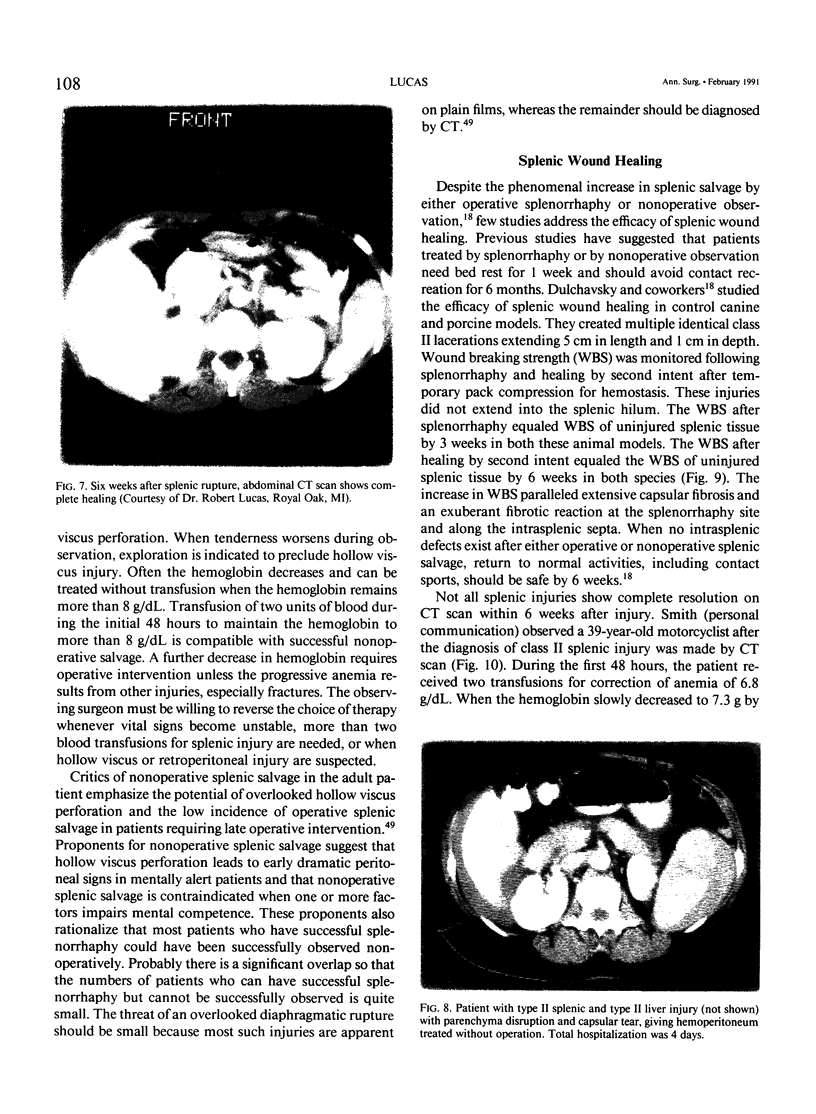
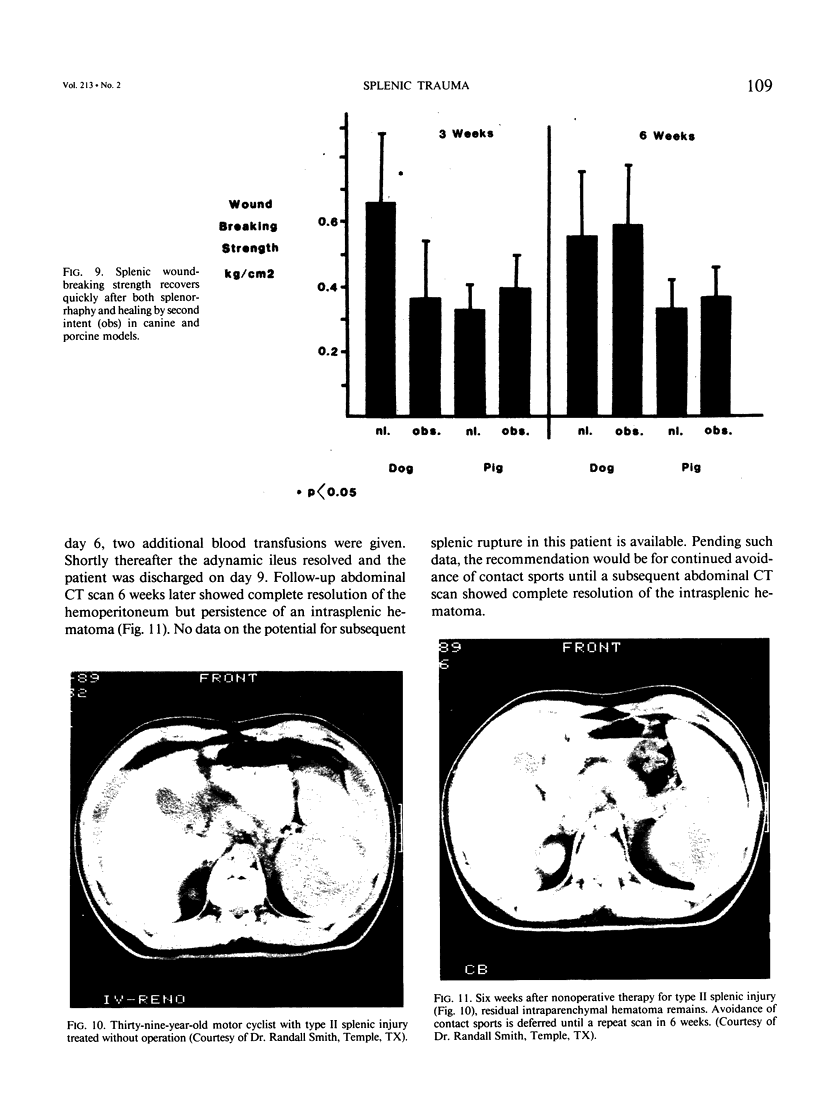

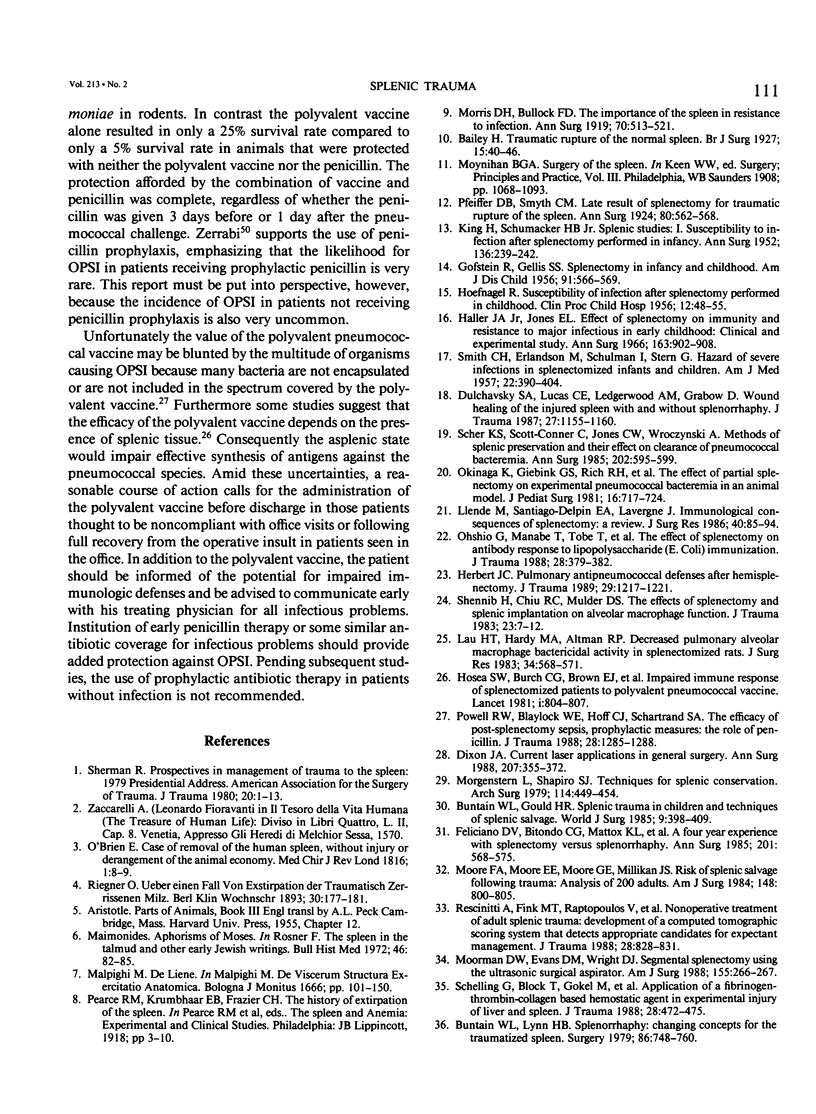
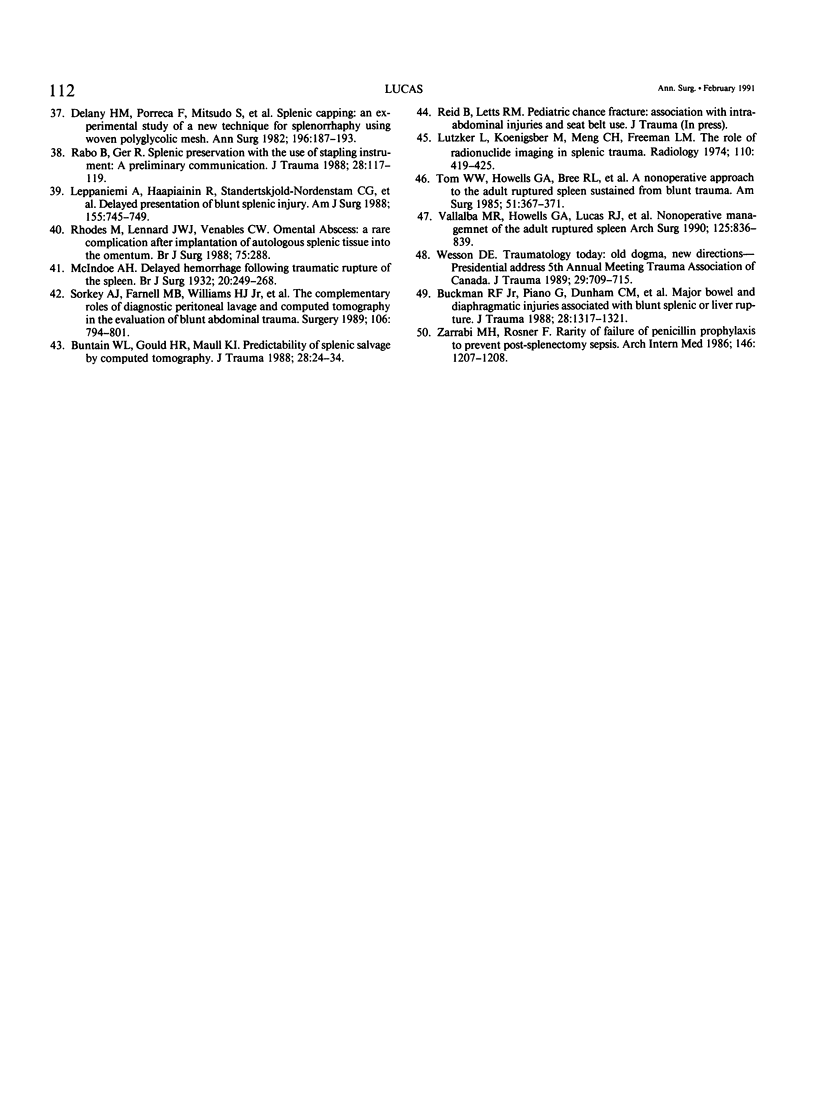
Images in this article
Selected References
These references are in PubMed. This may not be the complete list of references from this article.
- Buckman R. F., Jr, Piano G., Dunham C. M., Soutter I., Ramzy A., Militello P. R. Major bowel and diaphragmatic injuries associated with blunt spleen or liver rupture. J Trauma. 1988 Sep;28(9):1317–1321. doi: 10.1097/00005373-198809000-00004. [DOI] [PubMed] [Google Scholar]
- Buntain W. L., Gould H. R., Maull K. I. Predictability of splenic salvage by computed tomography. J Trauma. 1988 Jan;28(1):24–34. doi: 10.1097/00005373-198801000-00004. [DOI] [PubMed] [Google Scholar]
- Buntain W. L., Gould H. R. Splenic trauma in children and techniques of splenic salvage. World J Surg. 1985 Jun;9(3):398–409. doi: 10.1007/BF01655274. [DOI] [PubMed] [Google Scholar]
- Buntain W. L., Lynn H. B. Splenorrhaphy: changing concepts for the traumatized spleen. Surgery. 1979 Nov;86(5):748–760. [PubMed] [Google Scholar]
- Delany H. M., Porreca F., Mitsudo S., Solanki B., Rudavsky A. Splenic capping: an experimental study of a new technique for splenorrhaphy using woven polyglycolic acid mesh. Ann Surg. 1982 Aug;196(2):187–193. doi: 10.1097/00000658-198208000-00011. [DOI] [PMC free article] [PubMed] [Google Scholar]
- Dixon J. A. Current laser applications in general surgery. Ann Surg. 1988 Apr;207(4):355–372. doi: 10.1097/00000658-198804000-00001. [DOI] [PMC free article] [PubMed] [Google Scholar]
- Dulchavsky S. A., Lucas C. E., Ledgerwood A. M., Grabow D. Wound healing of the injured spleen with and without splenorrhaphy. J Trauma. 1987 Oct;27(10):1155–1160. doi: 10.1097/00005373-198710000-00010. [DOI] [PubMed] [Google Scholar]
- Feliciano D. V., Bitondo C. G., Mattox K. L., Rumisek J. D., Burch J. M., Jordan G. L., Jr A four-year experience with splenectomy versus splenorrhaphy. Ann Surg. 1985 May;201(5):568–575. doi: 10.1097/00000658-198505000-00005. [DOI] [PMC free article] [PubMed] [Google Scholar]
- GOFSTEIN R., GELLIS S. S. Splenectomy in infancy and childhood; the question of overwhelming infection following operation. AMA J Dis Child. 1956 Jun;91(6):566–569. doi: 10.1001/archpedi.1956.02060020568007. [DOI] [PubMed] [Google Scholar]
- HOEFNAGEL R. Susceptibility to infection after splenectomy performed in childhood. Clin Proc Child Hosp Dist Columbia. 1956 Mar;12(3):48–55. [PubMed] [Google Scholar]
- Haller J. A., Jr, Jones E. L. Effect of splenectomy on immunity and resistance to major infections in early childhood: clinical and experimental study. Ann Surg. 1966 Jun;163(6):902–908. doi: 10.1097/00000658-196606000-00011. [DOI] [PMC free article] [PubMed] [Google Scholar]
- Hebert J. C. Pulmonary antipneumococcal defenses after hemisplenectomy. J Trauma. 1989 Sep;29(9):1217–1221. doi: 10.1097/00005373-198909000-00005. [DOI] [PubMed] [Google Scholar]
- Hosea S. W., Burch C. G., Brown E. J., Berg R. A., Frank M. M. Impaired immune response of splenectomised patients to polyvalent pneumococcal vaccine. Lancet. 1981 Apr 11;1(8224):804–807. doi: 10.1016/s0140-6736(81)92681-7. [DOI] [PubMed] [Google Scholar]
- KING H., SHUMACKER H. B., Jr Splenic studies. I. Susceptibility to infection after splenectomy performed in infancy. Ann Surg. 1952 Aug;136(2):239–242. doi: 10.1097/00000658-195208000-00006. [DOI] [PMC free article] [PubMed] [Google Scholar]
- Lau H. T., Hardy M. A., Altman R. P. Decreased pulmonary alveolar macrophage bactericidal activity in splenectomized rats. J Surg Res. 1983 Jun;34(6):568–571. doi: 10.1016/0022-4804(83)90111-7. [DOI] [PubMed] [Google Scholar]
- Leppäniemi A., Haapiainen R., Standertskjöld-Nordenstam C. G., Taavitsainen M., Hästbacka J. Delayed presentation of blunt splenic injury. Am J Surg. 1988 Jun;155(6):745–749. doi: 10.1016/s0002-9610(88)80035-7. [DOI] [PubMed] [Google Scholar]
- Llende M., Santiago-Delpín E. A., Lavergne J. Immunobiological consequences of splenectomy: a review. J Surg Res. 1986 Jan;40(1):85–94. doi: 10.1016/0022-4804(86)90149-6. [DOI] [PubMed] [Google Scholar]
- Lutzker L., Koenigsberg M., Meng C. H., Freeman L. M. The role of radionuclide imaging in spleen trauma. Radiology. 1974 Feb;110(2):419–425. doi: 10.1148/110.2.419. [DOI] [PubMed] [Google Scholar]
- Moore F. A., Moore E. E., Moore G. E., Millikan J. S. Risk of splenic salvage after trauma. Analysis of 200 adults. Am J Surg. 1984 Dec;148(6):800–805. doi: 10.1016/0002-9610(84)90441-0. [DOI] [PubMed] [Google Scholar]
- Moorman D. W., Evans D. M., Wright D. J. Segmental splenectomy using the ultrasonic surgical aspirator. Am J Surg. 1988 Feb;155(2):266–267. doi: 10.1016/s0002-9610(88)80711-6. [DOI] [PubMed] [Google Scholar]
- Morgenstern L., Shapiro S. J. Techniques of splenic conservation. Arch Surg. 1979 Apr;114(4):449–454. doi: 10.1001/archsurg.1979.01370280103015. [DOI] [PubMed] [Google Scholar]
- Morris D. H., Bullock F. D. THE IMPORTANCE OF THE SPLEEN IN RESISTANCE TO INFECTION. Ann Surg. 1919 Nov;70(5):513–521. doi: 10.1097/00000658-191911000-00001. [DOI] [PMC free article] [PubMed] [Google Scholar]
- Ohshio G., Manabe T., Tobe T., Khine M., Hamashima Y. The effect of splenectomy on antibody response to lipopolysaccharide (E. coli) immunization. J Trauma. 1988 Mar;28(3):379–382. doi: 10.1097/00005373-198803000-00014. [DOI] [PubMed] [Google Scholar]
- Okinaga K., Giebink G. S., Rich R. H., Baesl T. J., Krishnanaik D., Leonard A. S. The effect of partial splenectomy on experimental pneumococcal bacteremia in an animal model. J Pediatr Surg. 1981 Oct;16(5):717–724. doi: 10.1016/s0022-3468(81)80559-3. [DOI] [PubMed] [Google Scholar]
- Pfeiffer D. B., Smyth C. M. LATE RESULTS OF SPLENECTOMY FOR TRAUMATIC RUPTURE OF THE SPLEEN. Ann Surg. 1924 Oct;80(4):562–568. doi: 10.1097/00000658-192410000-00011. [DOI] [PMC free article] [PubMed] [Google Scholar]
- Powell R. W., Blaylock W. E., Hoff C. J., Chartrand S. A. The efficacy of postsplenectomy sepsis prophylactic measures: the role of penicillin. J Trauma. 1988 Aug;28(8):1285–1288. doi: 10.1097/00005373-198808000-00027. [DOI] [PubMed] [Google Scholar]
- Ravo B., Ger R. Splenic preservation with the use of a stapling instrument: a preliminary communication. J Trauma. 1988 Jan;28(1):115–117. doi: 10.1097/00005373-198801000-00018. [DOI] [PubMed] [Google Scholar]
- Resciniti A., Fink M. P., Raptopoulos V., Davidoff A., Silva W. E. Nonoperative treatment of adult splenic trauma: development of a computed tomographic scoring system that detects appropriate candidates for expectant management. J Trauma. 1988 Jun;28(6):828–831. [PubMed] [Google Scholar]
- Rhodes M., Lennard T. W., Venables C. W. Omental abscess: a rare complication after implantation of autologous splenic tissue into the omentum. Br J Surg. 1988 Mar;75(3):288–288. doi: 10.1002/bjs.1800750334. [DOI] [PubMed] [Google Scholar]
- Rosner F. The spleen in the Talmud and other early Jewish Writings. Bull Hist Med. 1972 Jan-Feb;46(1):82–85. [PubMed] [Google Scholar]
- SMITH C. H., ERLANDSON M., SCHULMAN I., STERN G. Hazard of severe infections in splenectomized infants and children. Am J Med. 1957 Mar;22(3):390–404. doi: 10.1016/0002-9343(57)90095-5. [DOI] [PubMed] [Google Scholar]
- Schelling G., Block T., Gokel M., Blanke E., Hammer C., Brendel W. Application of a fibrinogen-thrombin-collagen-based hemostyptic agent in experimental injuries of liver and spleen. J Trauma. 1988 Apr;28(4):472–475. doi: 10.1097/00005373-198804000-00009. [DOI] [PubMed] [Google Scholar]
- Scher K. S., Scott-Conner C., Jones C. W., Wroczynski A. F. Methods of splenic preservation and their effect on clearance of pneumococcal bacteremia. Ann Surg. 1985 Nov;202(5):595–599. doi: 10.1097/00000658-198511000-00010. [DOI] [PMC free article] [PubMed] [Google Scholar]
- Shennib H., Chiu R. C., Mulder D. S. The effects of splenectomy and splenic implantation on alveolar macrophage function. J Trauma. 1983 Jan;23(1):7–12. doi: 10.1097/00005373-198301000-00002. [DOI] [PubMed] [Google Scholar]
- Sherman R. Perspectives in management of trauma to the spleen: 1979 presidential address, American Association for the Surgery of Trauma. J Trauma. 1980 Jan;20(1):1–13. [PubMed] [Google Scholar]
- Sorkey A. J., Farnell M. B., Williams H. J., Jr, Mucha P., Jr, Ilstrup D. M. The complementary roles of diagnostic peritoneal lavage and computed tomography in the evaluation of blunt abdominal trauma. Surgery. 1989 Oct;106(4):794–801. [PubMed] [Google Scholar]
- Tom W. W., Howells G. A., Bree R. L., Schwab R., Lucas R. J. A nonoperative approach to the adult ruptured spleen sustained from blunt trauma. Am Surg. 1985 Jul;51(7):367–371. [PubMed] [Google Scholar]
- Villalba M. R., Howells G. A., Lucas R. J., Glover J. L., Bendick P. J., Tran O., Jafri S. Z. Nonoperative management of the adult ruptured spleen. Arch Surg. 1990 Jul;125(7):836–839. doi: 10.1001/archsurg.1990.01410190028004. [DOI] [PubMed] [Google Scholar]
- Wesson D. E. Traumatology today: old dogma, new directions. Presidential address to the 5th annual meeting of the Trauma Association of Canada/L'Association Canadienne de Traumatologie. J Trauma. 1989 Jun;29(6):709–715. [PubMed] [Google Scholar]
- Zarrabi M. H., Rosner F. Rarity of failure of penicillin prophylaxis to prevent postsplenectomy sepsis. Arch Intern Med. 1986 Jun;146(6):1207–1208. [PubMed] [Google Scholar]







